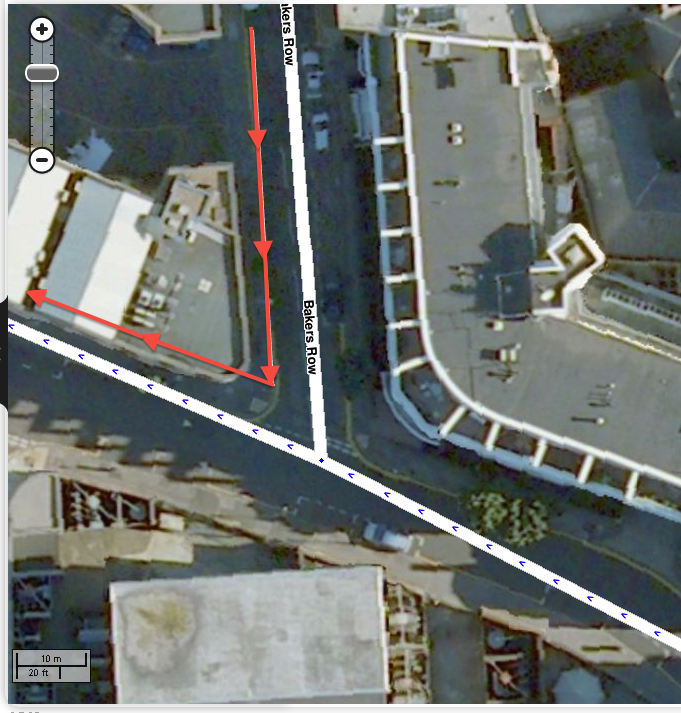(New page: NOTE (krankyd): these instructions could be dynamic. We'll try to keep this post updated whenever changes take place in the routing. == General comments == The description below fits a r...) |
|||
| Line 54: | Line 54: | ||
If the node was not locked, most likely that waze would tell you to turn right. Driving against the direction is a high penalty, and so is a left turn where a turn is not allowed. However, it would still have been an option, which is why the routing server would have called it 'turn right'.<br/><br/> | If the node was not locked, most likely that waze would tell you to turn right. Driving against the direction is a high penalty, and so is a left turn where a turn is not allowed. However, it would still have been an option, which is why the routing server would have called it 'turn right'.<br/><br/> | ||
[[image:Right_turn_1.png|700px|left]] | |||
This could be confusing, especially since there's no external indication on whether or not a node is locked at the moment. We will add it to the Papyrus soon. | This could be confusing, especially since there's no external indication on whether or not a node is locked at the moment. We will add it to the Papyrus soon. | ||
Revision as of 09:46, 23 January 2012
NOTE (krankyd): these instructions could be dynamic. We'll try to keep this post updated whenever changes take place in the routing.
General comments
The description below fits a right turn in a right-hand side driving country (e.g. not England). As you may guess, Left turns are symmetrical to right turns.
Definitions
a) s-in: the segment going into the junction
b) s-out: the segment going out of the junction
c) s1, s2 … sN: all the segments connected to the same junction
d) Best continuation - see expanded below
What is the 'best continuation'?
In order to determine if s-out is the 'real' continuation of s-in, we do the following:
- if s-out has the same road type & street name it is selected as the real continuation.
- if not, we look at the other segments: s3, s4 … sN. One of those will be chosen as a better continuation than s-out if both following conditions are met:
- this segment has a better match street name & road type wise than s-out (e.g. it has the same street name and s-out doesn't; it has the same road type as s-in, and s-out doesn't). Street name is more important than road type.
- the angle between this segment and s-in is smaller than the angle between s-out and s-in
The algorithm / list of conditions
The algorithm iterates over a list of conditions. As soon as a condition is met, the relevant instruction is determined, and the algorithm terminates.
The list of conditions:
1. if the junction has only 2 segments, the instruction is: 'CONTINUE'.
1.1. In some cases, T junctions could be considered as only 2 segments. See explanation on 'T junctions' below.
2. if the angle between s-out and the best continuation is larger than 45 degrees (and less than 180), the instruction is: 'TURN RIGHT'
2.1 One assumption is that on primary roads (minor highways, major highways and freeways), we won't have angles which are larger than 45 degrees.
3. if s-out is determined to be the best continuation of s-in (explanation on 'best continuation' below), the instruction is: 'CONTINUE'
4. if s-in is a primary road and s-out is not a primary road, the instruction is: 'EXIT RIGHT'
5. if s-in is a ramp/exit and s-out is neither primary nor ramp/exit, the instruction is: 'EXIT RIGHT'
6. if none of the above conditions is met, the instruction is: 'KEEP RIGHT'
T junctions and one way roads
In some cases, a node could have more than 2 segments, but the routing server will consider only 2 of them as valid and therefore, the maneuver will be 'Continue straight'.
Nodes can become locked on specific scenarios - see here Roundabouts for more information.
For example, in this case (image below) - assuming the node is locked - heading south, the right turn will be considered 'Continue straight' as the routing server has no other option and there's only one possible segment to be s-out.
If the node was not locked, most likely that waze would tell you to turn right. Driving against the direction is a high penalty, and so is a left turn where a turn is not allowed. However, it would still have been an option, which is why the routing server would have called it 'turn right'.

This could be confusing, especially since there's no external indication on whether or not a node is locked at the moment. We will add it to the Papyrus soon.